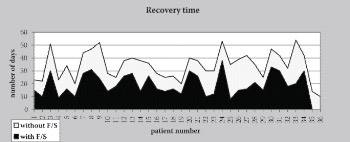The Role of Inhalatory Corticosteroids and Long Acting β2 Agonists in the Treatment of Patients Admitted to Hospital Due to Acute Exacerbations of Chronic Obstructive Pulmonary Disease (Aecopd)
DOI:
https://doi.org/10.17305/bjbms.2007.3026Keywords:
inhalatory corticosteroids, long acting β2 agonists, Acute Exacerbations of Chronic Obstructive Pulmonary Disease, treatmentAbstract
There is the question about the role of fixed combination of inhalatory corticosteroids and long acting β2 agonists in the treatment of patients admitted in hospital due to AECOPD.
The objective of this study is to determine the frequency of etiologic factors of AECOPD, to research the length of recovery time and the time free from exacerbation due to AECOPD at the patients treated with fixed combination inhalers containing F/S versus patients who were not treated with this combination.
This is retrospective-prospective, randomized, clinical study with a sample size of 70 patients who admitted to hospital due to AECOPD type I or II. Patients are randomized in two groups. Prospective group from 36 patients have been treated with oral or parenteral corticosteroids 7 - 14 days, other medications and fixed combination inhalers containing a F/S. Second, retrospective group from 34 patients have been treated with oral or parenteral corticosteroids 7 - 14 days (in time when we didn’t have fixed combination inhalers containing a F/S) and other medications. In both groups (prospective and retrospective) the most frequent etiological factors of AECOPD was bacterial infection, after that viral infection, other factors as well as congestive heart failure. Average recovery time for symptoms of AECOPD was statistically significant shorter in group patients treated with fixed combination inhalers containing F/S (prospective group) than in group treated without this fixed combination. There are also significant differences in average number of days need for recovery in subgroups of patients by etiological factors of AECOPD, except in cases of AECOPD onset because of congestive heart failure. Average free time from exacerbation at the patients treated with fixed combination inhalers was statistically significant longer than in group of patients who were not treated with this combination.
In this study has demonstrated the presence of pathogenic bacteria in 53% our patients hospitalized due to AECOPD. There were 26% patients whose exacerbation is signed as viral origin. 11% cases had congestive heart failure. Average recovery time for non-viral AECOPD was 14,8 days and for exacerbations of viral origin 27,4 days. Average free time from exacerbation at the patients treated with fixed combination inhalers containing a F/S was statistically significant longer than in group of patients who were not treated with this combination. There were no statistically significant differences in average number of exacerbation during the year, between observed groups.
Citations
Downloads

Downloads
Published
Issue
Section
Categories
How to Cite
Accepted 2018-01-19
Published 2007-11-20









